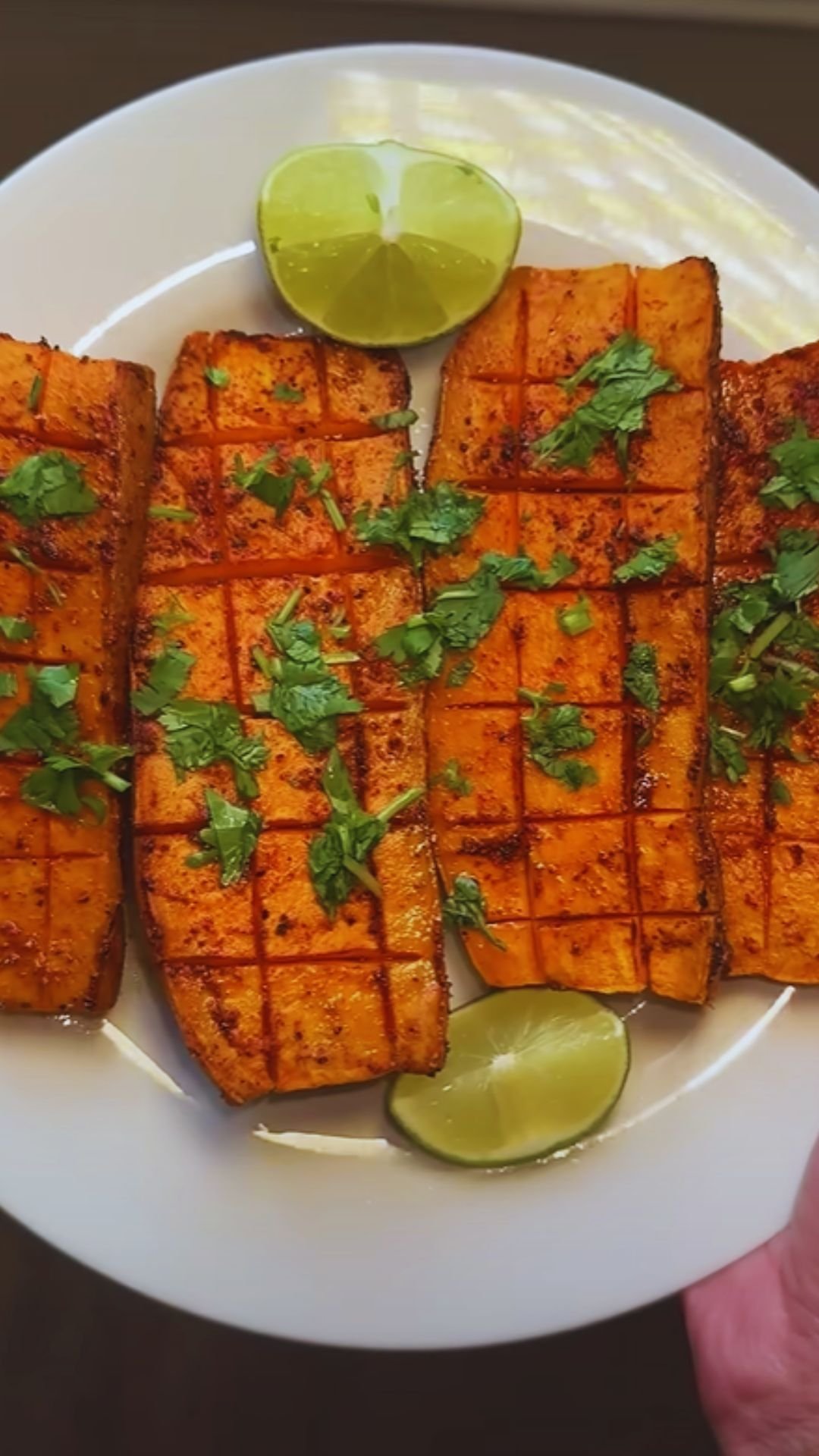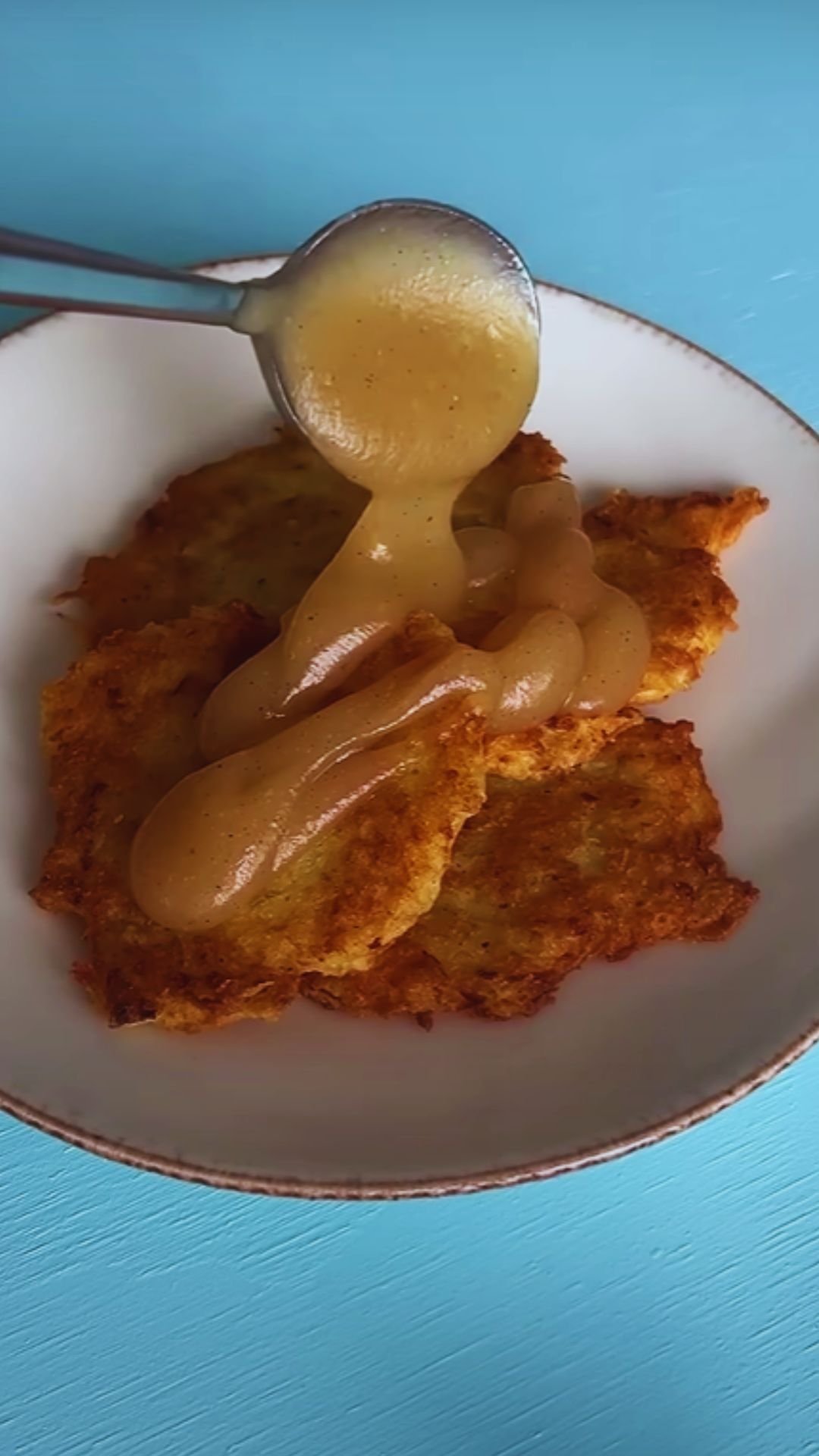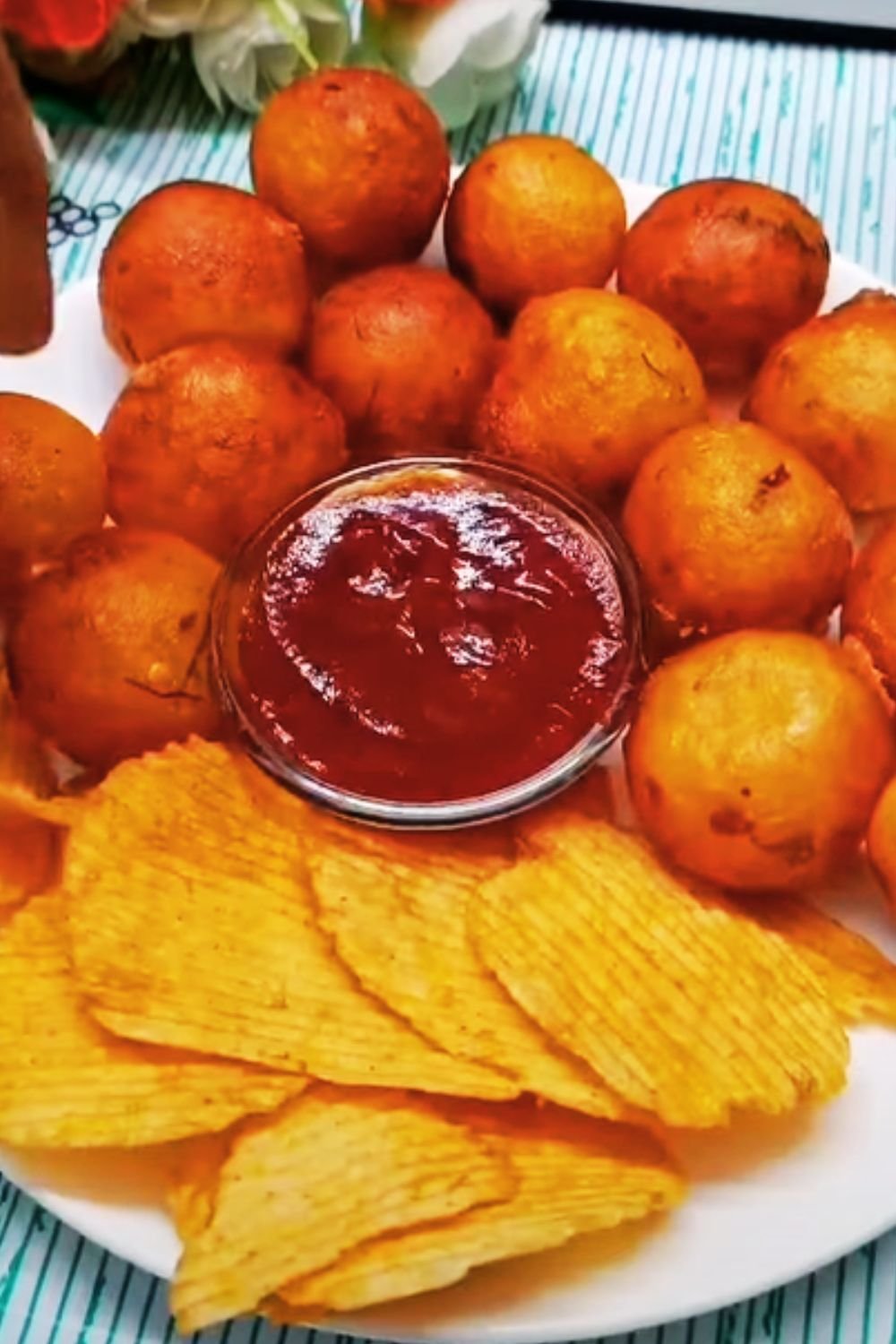Have you ever wondered how to transform ordinary sweet potatoes into those perfectly crispy, caramelized cubes that make your mouth water? I’ve spent years perfecting this seemingly simple dish, and I’m excited to share all my tips and tricks with you today. Roasted sweet potato cubes are not just delicious—they’re incredibly versatile, nutritious, and can elevate almost any meal from ordinary to extraordinary.
When I first started cooking, sweet potatoes intimidated me. Getting that perfect balance of crispy exterior and tender interior seemed like culinary magic. After countless batches (including many disappointments), I’ve nailed down a foolproof method that produces perfect results every single time. The best part? It’s ridiculously easy.
Why Sweet Potatoes Deserve a Regular Spot in Your Meal Rotation
Before diving into the recipe, let me share why I’m so passionate about these orange tubers. Sweet potatoes aren’t just tasty—they’re nutritional powerhouses that deserve a prime spot in your diet.
Sweet potatoes are packed with:
- Beta-carotene and vitamin A for eye health
- Fiber for digestive wellness
- Potassium for heart health
- Antioxidants that fight inflammation
- Complex carbs for sustained energy
What truly sets sweet potatoes apart is their remarkable versatility. They effortlessly transition between sweet and savory dishes, making them suitable for breakfast, lunch, dinner, and even dessert. I find myself reaching for them at least twice a week, and my family never complains about the repetition.
Selecting the Perfect Sweet Potatoes
The foundation of amazing roasted sweet potato cubes starts at the grocery store or farmer’s market. Here’s what I look for:
- Firmness: Choose sweet potatoes that feel firm and heavy for their size. Any soft spots indicate the beginning of spoilage.
- Smooth skin: While a few blemishes are normal, avoid potatoes with wrinkles, cracks, or discoloration.
- Size consistency: If preparing multiple sweet potatoes, try to select ones of similar size and shape for even cooking.
- Variety matters: Garnet, Jewel, and Beauregard varieties have the orange flesh we typically associate with sweet potatoes and work beautifully for roasting.

One common question I hear is whether to choose large or small sweet potatoes. In my experience, medium-sized potatoes offer the best flavor and texture. The giant ones can sometimes be stringy in the center, while the tiny ones might dry out during roasting.
Essential Equipment for Perfect Roasted Sweet Potatoes
You don’t need fancy equipment for this recipe, but having the right tools makes the process smoother:
- Sharp chef’s knife: Dull knives make cutting dense sweet potatoes dangerous and frustrating
- Sturdy cutting board: Preferably with non-slip features to keep it stable
- Large rimmed baking sheet: The rim prevents any oil from dripping into your oven
- Parchment paper or silicone baking mat: For easy cleanup and to prevent sticking
- Mixing bowl: For tossing the potatoes with oil and seasonings
- Spatula: A wide, sturdy one works best for flipping the potatoes
Having prepared countless batches, I’ve found that splitting the potato cubes between two baking sheets rather than crowding one sheet makes an enormous difference in achieving that perfect crispy exterior. When potatoes are packed too closely, they steam rather than roast, resulting in a softer texture.
The Science Behind Perfect Roasting
Understanding a bit of food science has dramatically improved my sweet potato roasting game. Here are the key principles that make a difference:
- Surface area matters: Smaller cubes have more surface area relative to their volume, resulting in more caramelization and crispiness. I find 3/4-inch cubes to be the perfect size.
- Dry potatoes roast better: Removing excess moisture from the surface allows for better browning. I always pat my cubes with paper towels before seasoning.
- Oil conducts heat: A proper coating of oil ensures even heat transfer from the pan to the potato. Too little oil leads to dry spots; too much creates sogginess.
- Sugar caramelization: Sweet potatoes have natural sugars that caramelize around 320°F, giving them that delicious flavor. A hot oven (400-425°F) is essential.
- The Maillard reaction: This chemical reaction between amino acids and reducing sugars creates hundreds of flavor compounds, giving roasted foods their distinctive taste.
Armed with this knowledge, you’re already ahead of most home cooks tackling this recipe!
Ingredient Breakdown with Substitution Options
Here’s everything you’ll need for basic roasted sweet potato cubes, along with my tested substitution recommendations:
| Ingredient | Amount | Function | Substitutions |
|---|---|---|---|
| Sweet potatoes | 2 lbs (about 3 medium) | Main ingredient | Butternut squash, yams |
| Olive oil | 2-3 tablespoons | Promotes browning, adds flavor | Avocado oil, melted coconut oil, ghee |
| Salt | 1 teaspoon | Enhances flavor | Kosher salt, sea salt (reduce quantity by 25%) |
| Black pepper | 1/2 teaspoon | Adds mild heat | White pepper (use half the amount) |
| Garlic powder | 1/2 teaspoon | Adds savory notes | Fresh minced garlic (1-2 cloves) |
| Paprika | 1/2 teaspoon | Adds color and mild flavor | Smoked paprika, chili powder |
| Fresh rosemary | 1 tablespoon (optional) | Adds aromatic flavor | Thyme, sage, or oregano |
| Maple syrup | 1 tablespoon (optional) | Enhances caramelization | Honey, brown sugar, or omit |
I love the flexibility of this recipe. When I’m cooking for kids, I might omit the black pepper and add a touch more maple syrup. For an adult dinner party, I’ll add a pinch of cayenne for heat and some fresh herbs for sophistication.
Step-by-Step Instructions: My Foolproof Method
Now for the heart of the article—the exact method I use to achieve perfectly roasted sweet potato cubes every time:
Preparation Phase
- Preheat your oven to 425°F (220°C). This high temperature is crucial for developing those crispy edges and caramelized flavors. Place the racks in the middle and lower-middle positions if roasting two sheets.
- Wash and dry the sweet potatoes. I scrub them thoroughly under cool running water, then dry completely with a clean kitchen towel. Removing excess moisture helps with crisping.
- Decision time: to peel or not to peel. I generally peel mine for a more refined texture, but the skins are entirely edible and add fiber. If keeping the skins, just make sure they’re very clean.
- Cut into consistent cubes. Aim for 3/4-inch cubes for the perfect balance of crispy exterior and tender interior. Start by cutting the potato in half lengthwise, then slice each half into planks, and finally cut the planks into cubes.
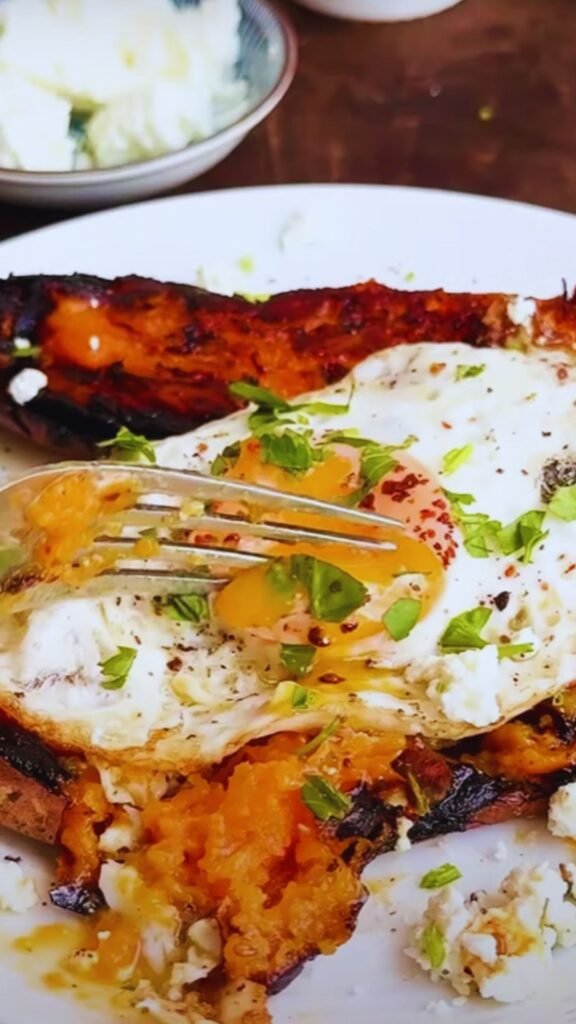
Seasoning and Roasting
- Place the cubed sweet potatoes in a large bowl. Working with dry potatoes helps the seasonings adhere better.
- Add oil and seasonings. Drizzle with olive oil and sprinkle with salt, pepper, garlic powder, paprika, and any optional seasonings you’re using.
- Toss thoroughly. Use your hands (my preferred method) or a spoon to ensure each cube is evenly coated with oil and seasonings. This step is crucial—uneven coating means uneven roasting.
- Arrange on baking sheets. Line your rimmed baking sheets with parchment paper or silicone mats, then spread the potatoes in a single layer. The most important rule: Don’t crowd the pan! Each cube should have a little space around it.
- Roast for 15 minutes, then remove from the oven and flip the cubes with a spatula. This promotes even browning on multiple sides.
- Return to the oven for another 10-15 minutes. The exact time will depend on your oven and the size of your cubes. They’re done when the edges are crispy and caramelized, and the centers are tender when pierced with a fork.
- Rest briefly before serving. I let mine cool for about 5 minutes, which allows the exterior to crisp up slightly more.
Common Problems and Solutions
If you’ve struggled with roasted sweet potatoes in the past, here are solutions to the most common issues:
- Problem: Potatoes are burning on the outside but still hard inside. Solution: Your cubes are likely too large or your oven temperature is too high. Cut smaller pieces or reduce temperature to 400°F and extend cooking time.
- Problem: Potatoes are soft instead of crispy. Solution: Your baking sheet is overcrowded, you didn’t use enough oil, or your oven isn’t hot enough. Give them more space, add a touch more oil, or increase your oven temperature.
- Problem: Uneven cooking with some pieces overdone. Solution: Your cubes are cut in inconsistent sizes. Take more time to ensure uniform cutting, and make sure to flip halfway through roasting.
- Problem: Seasoning tastes bland. Solution: Add salt immediately after roasting while potatoes are still hot. Consider using a finishing salt like Maldon for added flavor dimension.
Flavor Variations: Taking Your Roasted Sweet Potatoes to the Next Level
Once you’ve mastered the basic recipe, you can create endless variations by changing up the seasonings. Here are my favorite flavor profiles:
Sweet and Spicy
- 1/4 teaspoon cayenne pepper
- 1 tablespoon maple syrup
- 1/4 teaspoon cinnamon
- Pinch of nutmeg
Herbed Mediterranean
- 1 tablespoon fresh rosemary, minced
- 1 tablespoon fresh thyme, minced
- 2 cloves garlic, minced
- 1 teaspoon lemon zest (add after roasting)
Smoky Southwest
- 1 teaspoon smoked paprika
- 1/2 teaspoon cumin
- 1/2 teaspoon chili powder
- 1/4 teaspoon oregano
Curry Spiced
- 1 teaspoon curry powder
- 1/4 teaspoon turmeric
- 1/4 teaspoon garam masala
- 1/4 teaspoon coriander
I recommend trying each of these variations to discover your favorites. My family consistently requests the sweet and spicy version, especially during fall and winter months.
Serving Suggestions: Making a Meal Around Your Sweet Potatoes
Roasted sweet potato cubes are incredibly versatile and pair beautifully with many dishes. Here are my go-to serving ideas:
- Breakfast: Top with a fried egg and avocado slices for a hearty start to the day.
- Lunch: Toss into salads with mixed greens, quinoa, and a light vinaigrette.
- Dinner sides: Serve alongside grilled chicken, roasted salmon, or pan-seared tofu.
- Grain bowls: Use as the base for Buddha bowls with other roasted vegetables, a protein source, and tahini drizzle.
- Tacos: Add to black bean tacos with fresh cilantro and lime crema.
- Pasta alternative: Use as a partial pasta replacement in mac and cheese for added nutrition.
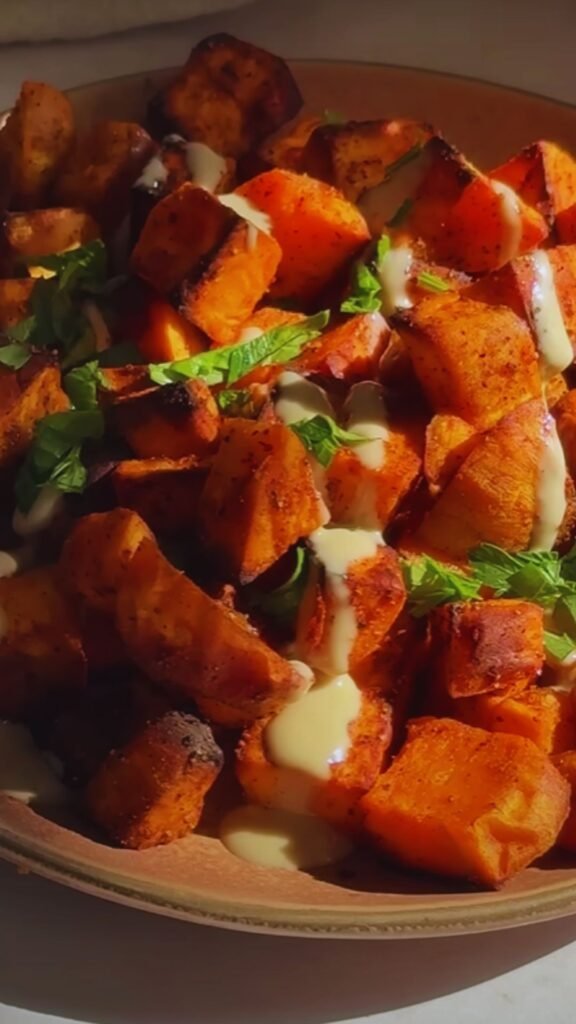
For a complete meal idea, I love serving these sweet potato cubes with herb-roasted chicken thighs and a simple arugula salad dressed with lemon juice and olive oil. The combination of flavors and textures is simply perfect.
Storage and Reheating: Extending the Life of Your Roasted Sweet Potatoes
One of the best things about this recipe is that it works wonderfully for meal prep. Here’s how I handle leftovers:
- Refrigerator storage: Place cooled roasted sweet potatoes in an airtight container. They’ll keep well for 4-5 days in the refrigerator.
- Freezer storage: For longer storage, freeze the completely cooled potatoes in a single layer on a baking sheet, then transfer to a freezer bag. They’ll maintain quality for up to 3 months.
- Reheating methods:
- Oven: Spread on a baking sheet and heat at 400°F for 5-7 minutes until crisp and hot.
- Skillet: Reheat in a skillet over medium heat for 3-5 minutes, stirring occasionally.
- Microwave: Quick but results in softer texture. Heat for 60-90 seconds, stirring halfway through.
- Air fryer: My favorite method! 3-4 minutes at 375°F restores much of the original crispiness.
| Reheating Method | Time | Temperature | Texture Result |
|---|---|---|---|
| Oven | 5-7 minutes | 400°F | Good crispiness, best for large portions |
| Skillet | 3-5 minutes | Medium heat | Nice crispiness, requires stirring |
| Microwave | 60-90 seconds | High | Softer texture, fastest method |
| Air Fryer | 3-4 minutes | 375°F | Excellent crispiness, best overall |
I often make a double batch specifically to have leftovers for quick weekday lunches. They’re delicious cold in a salad or reheated as a side with whatever protein I have on hand.
Nutritional Benefits: Why Sweet Potatoes Are a Superfood
I mentioned earlier that sweet potatoes are nutritional powerhouses, but let’s dive deeper into what makes them so special:
| Nutrient | Amount per 1 cup cubed | Benefits |
|---|---|---|
| Vitamin A | 377% of daily value | Supports vision, immune function, and cell growth |
| Vitamin C | 65% of daily value | Boosts immunity, collagen production, and iron absorption |
| Manganese | 28% of daily value | Helps with bone formation and blood clotting |
| Potassium | 448mg | Regulates blood pressure and heart function |
| Fiber | 4g | Promotes digestive health and helps control blood sugar |
| Complex Carbs | 27g | Provides sustained energy without blood sugar spikes |
| Antioxidants | High amounts | Fight free radicals and reduce inflammation |
The beautiful orange color comes from beta-carotene, which the body converts to vitamin A. Regular consumption of sweet potatoes has been linked to improved eye health, stronger immunity, and even better skin.
When I’m feeling low on energy or fighting a cold, I often increase my intake of sweet potatoes. They provide sustained energy without the crash that comes from simple carbohydrates, making them perfect for active lifestyles.
Frequently Asked Questions
After sharing this recipe with countless friends and family members, I’ve collected the most common questions people ask. Here are my answers:
Q: Do I really need to flip the sweet potatoes halfway through cooking? Yes, flipping is crucial for even browning. If you skip this step, you’ll end up with one very dark side and one pale side. The extra minute of effort makes a big difference in the final result.
Q: Can I use this same method for regular white potatoes? Absolutely! The method works beautifully for white potatoes, though they may need an extra 5-10 minutes of cooking time depending on their starch content.
Q: My sweet potatoes always stick to the pan. What am I doing wrong? This typically happens when the pan isn’t lined properly or the potatoes don’t have enough oil. Make sure to use parchment paper or a silicone mat, and ensure each cube has a light but complete coating of oil.
Q: Can I make these in an air fryer? Yes! Air fryers work wonderfully for sweet potato cubes. Cook at 380°F for about 15-20 minutes, shaking the basket every 5 minutes. You’ll likely need to work in batches for larger portions.
Q: Should I add maple syrup or other sweeteners? Sweet potatoes have natural sugars that caramelize beautifully during roasting. I find additional sweeteners unnecessary most of the time, but a light drizzle of maple syrup does enhance the caramelization if you prefer a sweeter result.
Q: Can I prepare the sweet potatoes ahead of time? You can cut the sweet potatoes up to 24 hours ahead, but store them in water in the refrigerator to prevent discoloration. Drain and dry thoroughly before roasting, as excess moisture prevents browning.
Q: How can I tell when they’re perfectly done? The perfect roasted sweet potato cube should have a crispy, caramelized exterior and a tender interior. Use a fork to test—it should slide in easily but meet slight resistance in the center. You’ll also see caramelized edges and slight crinkling of the surface.
Q: My sweet potatoes never get crispy. What’s wrong? Overcrowding is the most common culprit. Make sure the cubes aren’t touching on the baking sheet. Also, check that your oven temperature is accurate with an oven thermometer, as many home ovens run cooler than their settings indicate.
Final Thoughts: Why This Simple Dish Deserves a Place in Your Recipe Collection
There’s something magical about transforming a humble root vegetable into a dish that everyone at the table eagerly devours. What I love most about roasted sweet potato cubes is their ability to elevate almost any meal while being incredibly simple to prepare.
After years of cooking, I’ve found that the most beloved recipes aren’t always the most complex. This dish proves that simple ingredients treated with care can create something truly special. The contrast between the caramelized exterior and the tender, sweet interior creates a textural experience that even vegetable skeptics find irresistible.
Whether you’re a seasoned cook or just beginning your culinary journey, mastering roasted sweet potato cubes is a skill worth acquiring. They’re economical, nutritious, and adaptable to countless flavor profiles and meal contexts. Plus, they’re one of the few side dishes that rarely result in leftovers at my dinner table!
I hope this guide helps you achieve perfect results every time. Remember, cooking is both a science and an art—following these guidelines will give you the science, but don’t be afraid to add your own artistic touches as you become comfortable with the technique.
Quick Recipe Card for Easy Reference
| Easy Roasted Sweet Potato Cubes |
|---|
| Prep Time: 10 minutes |
| Cook Time: 25-30 minutes |
| Total Time: 35-40 minutes |
| Servings: 4 |
Ingredients:
- 2 lbs sweet potatoes (about 3 medium)
- 2-3 tablespoons olive oil
- 1 teaspoon salt
- 1/2 teaspoon black pepper
- 1/2 teaspoon garlic powder
- 1/2 teaspoon paprika
- Optional: 1 tablespoon fresh herbs (rosemary, thyme)
- Optional: 1 tablespoon maple syrup
Instructions:
- Preheat oven to 425°F (220°C)
- Peel and cut sweet potatoes into 3/4-inch cubes
- Toss with oil and seasonings
- Arrange in a single layer on lined baking sheets
- Roast for 15 minutes, then flip
- Continue roasting for 10-15 more minutes until crispy outside and tender inside
- Let rest for 5 minutes before serving
Nutrition Per Serving:
- Calories: 150
- Protein: 2g
- Carbohydrates: 27g
- Fiber: 4g
- Fat: 5g (from olive oil)
- Vitamin A: 377% DV
- Vitamin C: 65% DV
